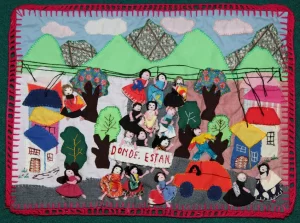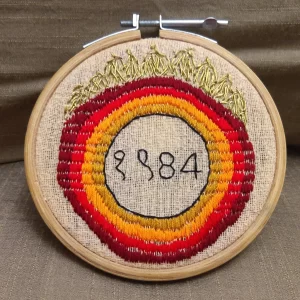Craft.
When you hear this word, what image comes to mind?
A woman, knitting or embroidering, maybe?
Or perhaps a group of women, sitting around and engaging in needlework or knitting, or sewing, with lots of laughter and gossip?
Definitely not a political prisoner sending messages to her co-plotters outside a detention facility. That is what happened in the 1980s, in Chile. And the Chileans are not alone in using craft to express dissent.
Most often, we think of craft as a “benign” activity, and indeed, that was what it was meant to be, a way to advertise your homeliness and marriageability. However, that was easier thought than done. In an article by Jessica Bateman in The Establishment, Ann Rippin, a researcher at the University of Bristol in the UK, says, “There was no way of controlling what women were actually thinking about while they were stitching.”

Part of the handkerchief embroidered by women detainees
From Britain’s suffrage movement, when women imprisoned in Halloway recorded their detention in prison using needlework, to India’s very own kolams and rangolis protesting the Citizenship Amendment Act, crafts and creativity have often intersected with activism to multiply their impact.
The history of craftivism, the term crafted by Betsy Greer, goes way back to France, and the tricoteuse, or the knitting woman, groups of whom would sit by the guillotine as the aristocrats would be killed during the French Revolution.

An arpirello with the iconic phrase “Donde Estan”. Courtesy: Ulster University
In Chile, for instance, mothers and wives sewed arpirellas (quilts) that depicted the horror of Pinoche’s brutal regime in the 1970s and 80s through simple imagery: scenes of domesticity with question marks instead of the men who would normally be present with the iconic phrase: Donde Estan (Where are they?). Women political prisoners would also sew arpilleras to send messages to their helpers outside. Guards would not even think of checking quilts for messages as they were considered just women’s work.
In Indonesia, artist Fitriani Dalay used knitting to yarn bomb public spaces to challenge the prevailing elitism of art and to highlight the country’s growing consumerist culture.

Rubina Singh’s embroidery commemorating the 1984 riots against Sikhs.
Down under, Knitting Nannas use knitting a bit differently, as a timid overlay to the atrocities they fight against.The Nannas are groups of women who make their presence felt at politicians’ offices, work sites, and rallies, as a front against fracking and other forms of destruction of the environment by sitting together and just knitting (or pursuing other everyday tasks such as shelling peas)! The contrast, of the calm knitting women and what is happening around them, reminds one of the French knitting women, bringing craftivism full circle, in a sense.
History and family craft plays a huge role in the choice of megaphone. During COVID, lawyer and activist Rubina Singh reflected on her grandmother’s art of phulkari embroidery, and began a series of embroidered art pieces that spoke about contemporary issues. Her grandmothers’ craft of Phulkari embroidery and their family history was instrumental in her choosing craft as the way to voice her opinion.
Through these, she says, she is “trying to mend our broken stories together and weave a new narrative.”
It seems like all of us are trying to do just that. These women found a way to do it: craft.
References:
https://www.mcgilldaily.com/2018/01/stitching-for-change/
https://acme-journal.org/index.php/acme/article/view/1739
https://knitting-nannas.com/about-us/what-we-do/
https://decoratingdissidence.com/2020/08/03/crafting-resistance-and-resilience/

